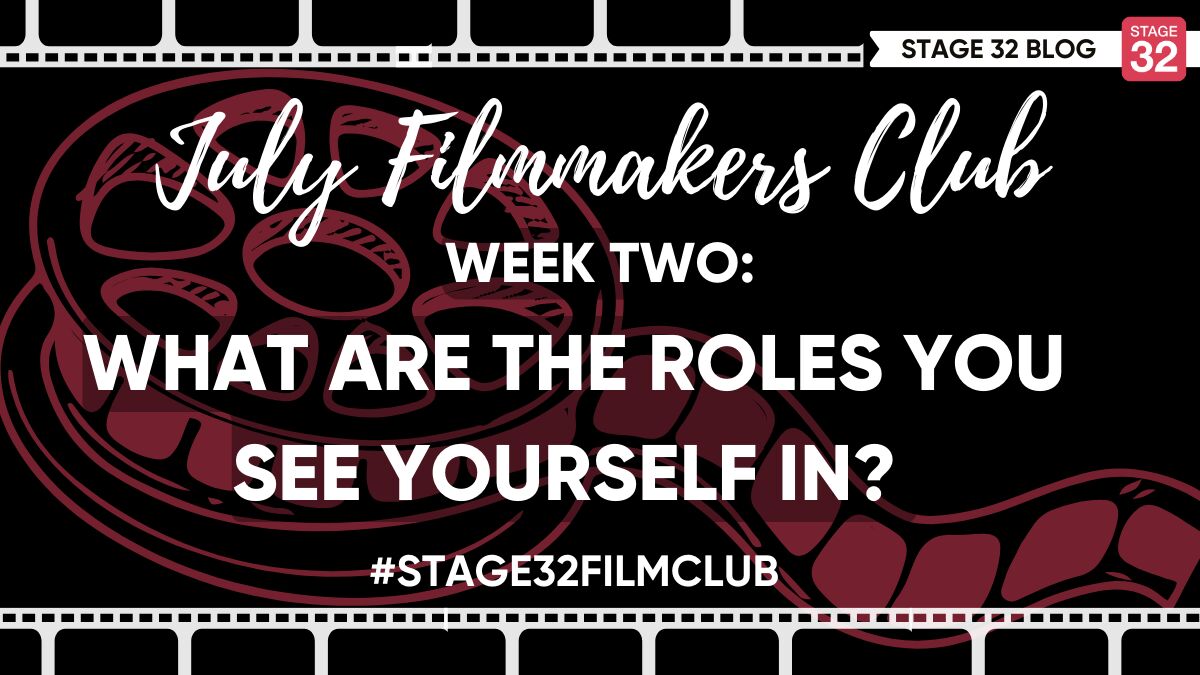July Filmmakers Club Week 2: What Are The Roles You See Yourself In?
Welcome to July Filmmakers Club, Stage 32!
Week 1 of July Filmmakers Club was an absolute blast! For any of you who missed it, you can go back and ready last Monday’s incredible blog HERE, jump into the Filmmaking Lounge to catch up with everyone HERE, or watch my live Q&A with Daniel Sol from HollyShorts on our @Stage32 Instagram HERE.
This week, we’re talking all things CREW. Most people, inside and outside of the industry, have familiarity with the primary “above the line” crew positions and creative forces behind a project. Yet many of the “below the line” crew positions that are integral to an efficiently run production set are overlooked and misunderstood.
While film buffs may stay after a film concludes and watch the credits scroll through to the end, noting all of the different professionals who added value to the final film, most don’t. It’s likely that many of you have yet to work on a professional set and may not be aware of all the crew positions that are available for you to explore and learn about. You may even discover that some of these roles align with your other skillsets and interests, presenting a different pathway to work on a set than you’ve ever considered before.
So let’s dive in…
Stage 32 Certification has Individual and Master Certification courses on almost all of the roles outlined below! You can learn more and register for these wonderful courses HERE. Once you become Certified through Stage 32, you will be entered into a global database searchable by film commissions, streamers, studios, production companies, independent producers, and financiers for work-placement opportunities around the world.
What Does “Above the Line” & “Below the Line” Mean?
These are two terms that are used a lot when discussing production and specifically crew hiring. Stemming from production budgeting, above-the-line, and below-the-line terms help to differentiate between the two most common types of payroll accounting. Over time, they’ve been embraced as terms that can represent the hierarchy of a set and are used widely in the industry.
“Above the line” positions are paid according to pre-negotiated rates agreed upon contractually when the person is hired or attached to the project. Typically, these roles are all involved early in the creative process, either in development or at the start of pre-production.
Examples of Above the Line Crew- Director, Producers, Principal Cast, Casting Director, etc.
Whereas “below the line” positions are hired as needed to work hourly or daily rates that are determined by the project or guild/union rules.
Examples of Below the Line Crew- Assistant Directors, Director of Photography, Production Designer, Gaffer, Best Boy, Grips, Hair and Makeup, Wardrobe, Props Master, Sound Mixer/ Boom Op, PAs, etc.
So let's take a closer look at these important roles, broken up by production departments, and what they bring to the table for each production.

Directorial
Director- In the world of film production, the Director is looked to as the primary voice and is responsible for the overall vision of the project. They’re the head of the production’s hierarchy, the person responsible for instructing every department to keep things running smoothly and to keep the goals and direction clear and aligned from pre-production through to the end of post.
1st Assistant Director- They’re the timekeepers. Responsible for overseeing the daily production schedule, managing the set, and keeping everything on track. They facilitate communication between all the departments and help to keep things running smoothly.
2nd Assistant Director- Responsible for distributing the next day’s vital information- distributing call sheets to everyone, wrangling the cast to be where they need to be on time, and occasionally even directing background performers and extras. Some larger productions even require a 2nd 2nd Assistant Director.
Script Supervisor- The continuity overlord. The script supervisor makes sure that the continuity of every scene and shot is maintained across the board. They keep track of every prop, bite of food, touch of the performer’s face, line delivery, etc. that happens in a shot is carried through and replicated to ensure that coverage and continuation of the scenes are seamless. They keep extensive notes and this attention to detail is crucial to making a film feel professional and intentional.
Producers
Executive Producers- On the business side of filmmaking, the true Captain of the ship is the EP. They’re typically the originators of the project, having acquired the IP for adaptation, the script on spec, or developed the original concept & pitch with the writer. Oftentimes they also put the initial creative team together, seek out or provide funding, and are the go-between for the creative team and investors, studio execs, etc.
Producer/Associate Producer- Work under the EP and alongside the Line Producer to manage all operations on the business side. They oversee the budgets, schedules, and any business needs.
Line Producer- Works under the EP to manage all things BUDGET. They break down the script from a production perspective to put the initial budget together and oversee it throughout the full production process. One of the most important roles on set, they’re also involved in crew hiring, and scheduling, and are the boots-on-the-ground problem-solver as needed.
Unit Production Manager (UPM)- Works under the Line Producer to ensure that the primary production paperwork such as contracts, reports, schedules, budgets, payroll forms, call sheets, memos, etc. are all completed, signed, and organized.
Production Coordinator- The support for the Line Producer and UPM, organizing all of the paperwork, and administrative duties, and supervising all Production Assistants.

Casting
Casting Director- Manages the overall casting process of a film. From organizing casting calls, auditions, self-tapes, and chemistry reads, to seeking out particular talent through their professional relationships and finding the best-fit talent for every role. Great casting directors even push to have specific actors get considered for roles that seem like a departure from their previous work or may seem different on paper than the director and producer's original concept. They're the champions of giving the best talent a chance at the role.
Cast
Principal Cast- Sometimes referred to as “major speaking roles” or “primary talent”, the principal cast is made up of the actors portraying the scripted roles integral to the story. The hierarchy of the principal cast is determined by many factors and outlined in the cast list on the daily call sheet. The most important actors will always be listed first and the order descends from there.
Background Actors (Extras)- Typical non-speaking roles or roles with simple one-two lines that help to fill in the story, location, or background of a scene. They’re supervised by the 2nd assistant director and costumed to fit seamlessly into the world of the story.

Hair, Makeup, & Wardrobe
Makeup Artists- Design and apply all traditional makeup needed on the cast throughout a shooting day.
Special Effects Makeup Artist- Oversees the design and application of prosthetics, fake blood, or anything that transforms the cast with makeup.
Hair Stylists- Design and style each cast member/character’s hairstyle and maintain those looks throughout the film’s production.
Costume Designer- Designs and approves all costumes and wardrobe for a production. They sometimes create the costume designs themselves or collaborate with tailors, cobblers, and professional shoppers to source specific fashion pieces.
Wardrobe Supervisor- Responsible for organizing all of the wardrobe pieces and keeping them maintained.
Art Department
Production Designer- Head of the art department, responsible for designing all sets and set pieces for the film. They also oversee the set-dressing, props, and overall style or aesthetic of the physical and tangible world of the story.
Art Director- Brings the Production Designer’s plans to fruition and oversees the department crew on set or location.
Location Manager- Ensuring that all locations are prepared and secured for shooting days. They’re responsible for identifying nearby parking, bathrooms, and power sources. They secure permits and close off public areas as needed.
Location Scout- Seeks out locations that fit the story, director’s vision, and production schedule/ budget.
Construction Coordinator- Oversees the actual construction of all set pieces, facades, and anything else that the production designer needs physically built.
Set Decorators & Dressers- Discover and place room or setting decorations such as furniture pieces, art, rugs, bedding, curtains, photos, belongings, etc. that fill the space in a way that aligns with the characters involved, the director’s vision, and the production designers plans. I like to think of them as the wizards who transform a set into a relatable lived-in space.
Prop Master- Creates, acquires, tracks, and maintains all props that are used in the film.

Camera & Lighting
Director of Photography/ Cinematographer- The head of the Camera/Lighting department, responsible for creating the overall visual style and look of the film to best fit the Director’s vision.
First Assistant Camera Operator (Focus Puller)- Operates the primary camera and is responsible for making sure that all of the camera’s settings are dialed in correctly for the particular shot and for keeping the subject of each shot in focus or properly adjusting the focus between subjects as needed.
Second Assistant Camera (Slate)- Responsible for filming the slate that identifies each individual take with updated details, organizing all of the camera gear and lenses, and keeping records and notes of all needs or changes.
Digital Imaging Techs (DIT)- Responsible for the digital workflow on sets that utilize digital cameras and gear. They make sure that the camera settings are correct, that the colors and look of the shot are aligned with the DP’s intentions and continuity, and manage all of the digital dailies.
Grip & Electric
Gaffer- Head of the electrical department, reporting directly to the Cinematographer to coordinate the proper lighting of every scene according to the project’s vision and the camera department’s needs.
Best Boy/Girl/Person (Electrical)- Works directly under the Gaffer to oversee all electrical cables, generators, and electrical crew. They’re directly involved in crew hiring, organizing the necessary gear, and overseeing the day-to-day operations of the department.
Electrical Technician & Generator Operators- Responsible for running all electrical cables to the lights and in-studio or on-location generators and ensuring that they’re being properly set up and run to not blow any fuses or cause any electrical problems.
Key Grip- Works under the Gaffer to oversee all non-electrical gear and equipment. They supervise the Grip department in rigging lights, camera gear, stabilizers, etc. They’re responsible for the overall safety and procedures of their department.
Grips & Rigging- The brute force and power on a set. Grips are responsible for rigging, moving, or setting up all equipment. Anything and everything that needs to be moved is moved by a Grip. When on location, they also oversee and organize the Grip Truck with all of their gear and supplies.

Sound Department
Sound Mixer- Oversees the audio recordings on set and on location. They ensure that they’re properly picking up and mixing all of the dialogue, necessary background noise, and even room tone/ ambiance. If something is missed or improperly recorded, it’s their job to speak up and make sure that another take is filmed to properly record.
Boom Operator- Responsible for holding, handling, and caring for the boom microphone.
Stunts & VFX
Stunt Coordinator- Designs and plans all of the stunts necessary for the film’s production and hires the skilled stunt crew and cast needed to accomplish them as safely as possible.
Fight Choreographer- Designs and carefully choreographs all fight scenes.
Stunt Performers- Trained to carefully perform all stunts in place of the actors in the film.
VFX Supervisor- Oversees the capture of all VFX shots and ensures that the proper equipment is present to do so.

Transportation
Transportation Captain- Oversees all transportation, drivers, and equipment needed to get crew, cast, and gear to set and locations. They coordinate a plan, schedule, and even a budget to make sure that it’s all taken care of properly and no mistakes are made.
Drivers- Responsible for physically transporting cast, crew, and equipment safely to and from set or location.
Production Assistants
Production Assistants are the primary support staff for all departments. There are Casting Assistants, Set PAs, Sound PAs, Art PAs, Location PAs, Office PAs, etc. This is the most entry-level production crew position available on a set. It’s where almost anyone starts in the industry and it’s a way to learn a lot in a condensed period about all areas of production.
Additional On-Set Roles
Production Accountant- Responsible for tracking and issuing all expenses, budgets, and payroll.
Intimacy Coordinator- Helps to choreograph intimate scenes with the director to ensure that the scenes are handled safely and most importantly, consensually, and that the actors are comfortable when performing the scene.
Still Photographer- Responsible for taking behind-the-scenes photos throughout the production process that can later be used for publicity, keeping track of continuity, etc.
Set Tutor- Any ongoing sets with children under the age of 18 are required to have an on-set tutor for children to be properly educated while on set. This ensures that they keep up with their homework, and exams, and aren’t getting left behind while away from school for weeks or months at a time.
Set Medic- A trained paramedic or EMT available on set to provide necessary medical assistance to crew and cast as needed.

This Week's July Filmmakers Club Challenge!
For your second week of July Filmmakers Club, we want to know which crew roles interest you the most! By completing this week's challenges, you can set yourself up for further success in networking and be entered to win a FREE Stage 32 Contest Entry that will be announced LIVE on Stage 32's Instagram this Friday, July 12th at 12:00 pm PT!
Week Two Challenges:
- Comment on this blog below sharing your thoughts- were any of these crew roles entirely new to you? What are the roles that you'd like to learn more about or explore for yourself?
- Post in the Stage 32 Filmmaking Club Lounge sharing a favorite story from your time on set or posing a question that you'd like answered about set etiquette, crew roles, or production (You can find it quickly by clicking HERE).
- Comment on at least 3 other members' posts in the Stage 32 Filmmaking Lounge to offer insights, words of encouragement, or support!
Make sure you're following @Stage32 and @rbwalksintoabar to keep up with all of the exciting July Filmmakers Club announcements all month long!
Let's hear your thoughts in the comments below!
Got an idea for a post? Or have you collaborated with Stage 32 members to create a project? We'd love to hear about it. Email Ashley at blog@stage32.com and let's get your post published!
Please help support your fellow Stage 32ers by sharing this on social. Check out the social media buttons at the top to share on Instagram @stage32 Twitter @stage32 Facebook @stage32 and LinkedIn @stage-32
| The Secrets To Hiring A Great Crew |
| Coffee & Content: The Benefit of Being a Multi-Hyphenate |
Search Stage 32 Blog
There are now 4055 blog posts for you to enjoy. Search them all by tags below.
Acting, Advice, Cinematography, Coffee & Content, Composing, Contests, Distribution, Featured, Filmmaking, Financing, Inspirational, Networking, Producing, Screenwriting, Success Stories, Tips, Trending,Relevant Tags
Recommended Articles

Coffee & Content: Know Who You Are, Know Who You’re Pitching To

From Beats to Boards: A Systematic Way to Plan Your Screenplay

Insider Intel: 2025- Your Year of Breakthroughs (+ What's Coming in 2026)

Stage 32 Certification Featured In IndieWire!

Find Your Footing on Stage 32: Join Our December Community Open House

Stage 32 Featured at the 43rd Torino Film Festival!

Stage 32 + DramaBox Join Forces to Launch World's First Vertical Drama Incubator

Green Lights and Grey Areas: Expanding Creative Collaboration in Publishing

Stage 32 Now Certifying the Dallas Film Commission!







